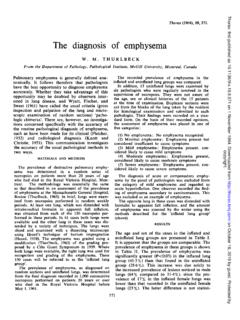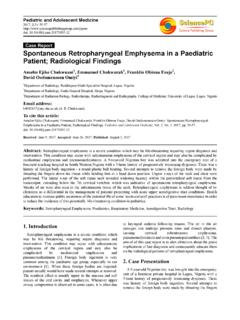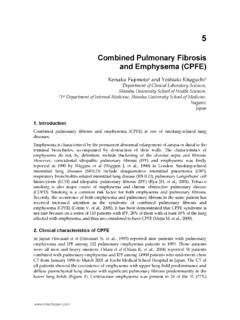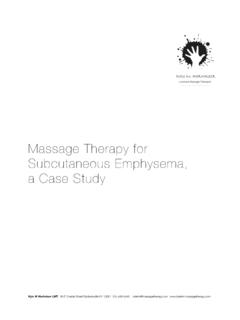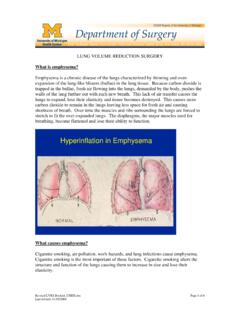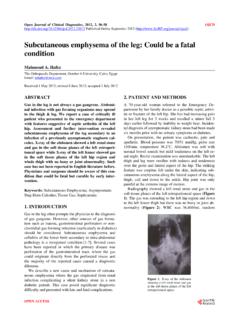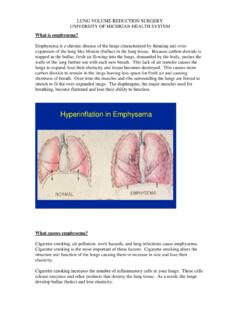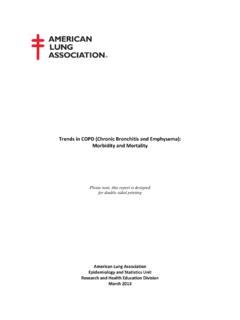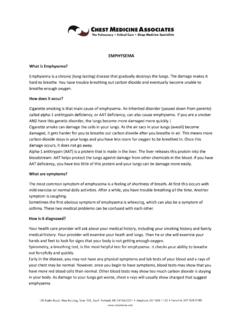Transcription of Chronic Obstructive Pulmonary Disease (COPD)
1 Chronic Obstructive Pulmonary Disease ( copd ) copd :OutlineCOPD: Outline DefinitionDefinition Etiology Epidemiology Epidemiology PathophysiologyCli i lPtti Clinical Presentation Diagnosis Prevention TreatmentCOPD:DefinitionCOPD: DefinitionChronic airflow obstruction due to Chronic bronchitis and/or Pulmonary emphysemaCOPD:DefinitionCOPD: DefinitionChronicairflow obstruction due to Chronic bronchitis and/or Pulmonary emphysemaCOPDis a chronicdiseaseCOPD is a Chronic Disease NotacuteairflowobstructionNotacute airflow obstruction Bronchitis/bronchiolitisAsthmaattack Asthma attack Not(completely)reversible Not(completely) reversible Asthma reversibleairflow obstructionCOPD:DefinitionCOPD: DefinitionChronic airflow obstruction due to Chronic bronchitis and/or Pulmonary emphysemaAirflowObstructionAirflow Obstruction Definitionof airflowobstructionDefinition of airflow obstruction FEV1/FVC < aka Obstructive ventilatory defect Alternative definition FEV1/FVC < lower limit of normal copd :DefinitionCOPD.
2 DefinitionChronic airflow obstruction due to Chronic bronchitisand/or Pulmonary emphysemaChronicBronchitisChronic Bronchitis DefinitionDefinition persistent cough and sputum production for at leastthreemonthsin at leasttwo consecutiveleast three months in at least two consecutive years SubmucosalglandhyperplasiaSubmucosalglan d hyperplasia Airway edema Mlid ifib i Mucus plugging and airways fibrosis Typesof AirflowObstructionTypes of Airflow , , , Loss of radial tractionCOPD:DefinitionCOPD: DefinitionChronic airflow obstruction due to Chronic bronchitis and/or Pulmonary emphysemaPulmonaryEmphysemaPulmonary emphysema Destruction ofacinarwallsDestruction of acinarwalls Physiologic effectsyg Loss of radial traction on airways Increased lung compliance Consequences Consequences Hyperinflation Poorlung mechanicsPoor lung mechanicsCentrilobularemphsyemaCentrilob ular emphsyema Smoking related Upper lobe predominantPanlobular emphsyema alpha 1 antitrypsin deficiency Lower lobe (basilar) or diffuseCausesof AirflowObstructionCauses of Airflow Obstruction Upper airway obstruction Lower airway obstruction copd AsthmaAsthma Bronchiectasis ( , cystic fibrosis) Large airway obstructionTumor stenosis foreign body aspiration et al Tumor, stenosis, foreign body aspiration, et al.
3 Bronchiolitis Pulmonary edema Carcinoid syndromeCOPD:DefinitionCOPD: DefinitionChronic airflow obstruction due to Chronic bronchitis and/or Pulmonary emphysema (Persistent post bronchodilator FEV1/FVC < not due to diseasesotherthanCOPD)not due to diseases other than copd )LeadingCausesof Deathin the US, 2006 Leading Causes of Death in the US, 2006800,000400 000600,000200,000400,0000 Heart Disease Is as Prevalent as Many Other Chronic Diseases Treated in Primary 23040er 1000 *CVDHTNO besity*All About Diabetes. American Diabetes Association Web site. 90% t 95% f Ai ith di b t h t 2 di b t AHA Ht Di d Stk 90% to 95% of Americans with diabetes have type 2 diabetes. AHA. Heart Disease and Stroke Statistics 2004 Update. Dallas, TX: AHA; asked questions on overweight and obesity.
4 CDC Web site. #adults. Percent Change in Age-Adjusted US Death All Other +163%GOLD. Available at: Accessed July 13, 2006 (A).Risk Factorsfor COPDRisk Factors for COPDG enetic variationSmokingand LungFunctionSmoking and Lung FunctionAnthonisen, JAMA 1994 LungFunctionOver TimeLung Function Over TimeNever smoked or notsusceptibleto smoke100susceptible to smokeSymptoms75 Age 25 Stopped smoking at 45 (mild copd )Smoked regularly and susceptible to fff k50 Relative to Stopped smoking at 65 DeathDisabilityeffects of smoking25 FEV1(%) R(severe copd )Death5075250 Fletcher BMJ 1977 Age (years)Smokingand copd riskSmoking and copd riskLokke, Thorax 2006 1 antitrypsin(AAT)Deficiency 1antitrypsin (AAT) Deficiency Autosomal co dominant Paper electrophoresis of patient serumdisorder caused by mutation in the SERPINA1geneCase 1 SERPINA1gene Phenotypes classified by migrationinControlby migration in isoelectric pH gradient from A to Z (slowest iti)Case 2migration)Laurell and Eriksson 1963 AAT allelesAAT allelesAllele GroupsExamplesDefectppNormal MNoneX (Glu363 Lys)DeficiencyS (Glu264 Val)Intracellular degradation ltiZ (Glu342 Lys)Mmalton(Phe52del)or accumulationNllT 160 XNRNAt iNullTyr160 XNo mRNA or proteinDysfunctionalMDefective inhibition ofDysfunctionalMmineral springsMet358 ArgDefective inhibition of elastaseStoller JK and Aboussouan LS.
5 Lancet genotypes and emphysema riskAAT genotypes and emphysema risk GenotypePrevalenceA1AT SerumRisk of ypConcentrationEmphysemaMM91%150-350 mg/dLBackgroundMS6%110-340 mg/dLBackgroundMZ3%90210/dLBkdMZ3%90-210 mg/dL20-50% mg/dL80-100%Stoller JK and Aboussouan LS. Lancet 2005. 1-antitrypsin Deficiency (AAT) 1antitrypsin Deficiency (AAT) 2% of copd pts have severe A1AD 59,000 Americans Only 10,000 are receiving replacement therapy AAT inhibits neutrophil elastase Panlobularemphysemapy Younger pts with basilaremphysema Can also cause liver Disease Treatment Intravenous pooled plasma 1-antitrypsin May slow the decline in lung functionMatrix metalloproteinase 12 and kCOPD riskHunninghake, NEJM 2009 Respiratory SystemSystem MechanicsCGas ExchangeCauses of DiseaseStructural ChangeFunctionalChangeDiseaseVentilation Physical examinationVascularCh Physical examination Radiographic examination Histological examinationChangesLung Compliance is Increased in lhPulmonary EmphysemaComparison of Lung Volume ParametersTLCTLCICICIRV lumelumeICICTLCTLCIRVERVVVTTVoVoERVVVTTF RCFRCRVRVFRCFRCERVRVCOPDCOPDN ormalNormalAirway Resistance is determined b ilibby Airway , , , Loss of radial tractionDynamic Airway Compression during diiForced ExpirationGas exchangein COPDGas exchange in copd Mildhypoxemiais commonMild hypoxemia is common Severe hypoxemia is rarehif hi Mechanisms of hypoxemia Increased V/Q mismatch (MAJOR) Alveolar hypoventilation (minor)
6 Shunt and diffusion abnormalities do NOT contribute to hypoxemia in COPDA bnormalVentilationin COPDA bnormal Ventilation in copd IncreaseddeadspaceventilationIncreased dead space ventilation Emphysematous regions are poorly perfused Increasedworkof breathing Increased work of breathing Alveolar hypoventilation() Common (but not universal) in advanced Disease Worsens during severe exacerbations (acute dt i tift i thttif tdeterioration often in the setting of acute bronchitis)ClinicalPresentationof COPDC linical Presentation of copd Millions have early, asymptomatic COPDy, yp Common symptomsh hd(hbh) Cough with sputum production ( Chronic bronchitis) Exertional dyspnea MuscularwastingMuscular wasting During an exacerbationhl Change in sputum quantity, color, or consistency Wheezing IncreaseddyspneaIncreased dyspneaPhysical Examin COPDP hysical Exam in copd Early Disease = normal exam Common findings Increasedanteroposteriorchestdiameter Increased anteroposteriorchest diameter Barrel chest Bilaterally diminished breath sounds Muscularwasting Muscular wasting During an exacerbation Wheezing Rhonchi CyanosisyCOPDVS NORMAL:PACOPD VS NORMAL: PAEMPHYSEMAEMPHYSEMANORMALCOPDVSNORMAL:L ATERALCOPD VS NORMAL: LATERALEMPHYSEMANORMALCOPDVS NORMAL:CTCOPD VS NORMAL.
7 CTEMPHYSEMANORMALD iagnosingCOPDD iagnosing copd ClinicalpresentationClinical presentation Airflow obstruction without reversibilitylif li Exclusion of alternative causes Asthma Bronchiecatasis ( , cystic fibrosis) Congestive heart failure Tuberculosis Other causes of airflow obstructionSpirometry is the BEST test for ddfdiagnosis and staging of COPDS tageFEV1/FVCFEV1 OtherI: Mild< >80% predictedII: Moderate< to 79%III: Severe< to 49%PaO2>60 mm Hg, andandPaCO2<50 mm HgIV: Very Severe< to 49%PaO2< 60 mm HgororPaCO2> 50 mm Hg< <30%Managementby copd stageManagement by copd stageStageFEV1 ConsiderI: Mild>80% Risk factor reduction Influenza/pneumococcalvaccinationInfluen za/pneumococcalvaccination Short acting inhaled 2 agonistsII: Moderate50 to 79% Long acting inhaled bronchodilators Pulmonaryrehabilitation Pulmonary rehabilitationIII: Severe30 to 49% Inhaled corticosteroids (if wheezing or repeated exacerbations)IV.
8 Very Severe<30%* Long term oxygen therapy Surgical therapyBrief Strategies to Help the Patient Willing to Quit SmokingPatient Willing to Quit Smoking ASKI dentify smokers at every visit ADVISES trongly urge all users to quit ASSESSD etermine willingness to quit ASSISTAid the patient in quitting ARRANGES chedule follow-up contactPharmacologic therapies for tobacco cessationAgentUsage6 monthabstinence rateNicotine replacementAll about 25%Nicotine polacrilex (gum)2 4mg piece every 1 2 hrsx 8 12 weeksNicotine lozenges1 2mg every hourNasal nicotine mg inh each nostril hourly pygyx 3 6 monthsNicotine inhaler6 16 cartridges/day x 3 6 monthsTransdermal nicotine (patch)16 24hrs/day x8 weeks(p )/yOral medicationBuproprion sustained release 150mg for 3 days, then 300mg daily x up to 6 months24%x up to 6 monthsVareniclineSee next slide33%VareniclineVarenicline Orally available partial agonist at the 4 2 subunit of the nicotinic acetylcholinereceptoracetylcholine receptor Effects Stimulates nicotinic receptor (reduces withdrawal)p () Block nicotine from binding (reduces reward) Increases the odds of quitting three fold (33% 6 month quit rate) Use: daily x 3 days, then mg BID for 4 days, then 1mg BID for 11 more 1 kft i iti tiili Quit smoking 1 weeks after initiating varenicline Successful quitters at 12 weeks should continue for 12 more weeks Side effects: nausea, insomnia, abnormal dreams Concerns: ?
9 Suicidal thoughts, aggressive/erratic behaviorSuggested approach to smoking cessation Use the 5 A sUse the 5 As Dual approach CounselingCounseling Pharmacologic therapy Varenicline most effective May be combined with nicotine replacement Tailor therapy to the individual Comorbidities PreferencesSelected Inhaled Medications for COPDType of DrugDrugTrade NamesType of DrugDrugTrade NamesShort-acting 2-agonist (SABA)AlbuterolTerbutalinePirbuterolVent olinBrethineMaxairagonist (SABA)PirbuterolLevalbuterolMaxairXopene xLong-acting 2-agonist (LABA)FormoterolArformoterolForadilBrova naagonist (LABA)SalmeterolSereventAnticholinergicI pratropium (short-acting)Tiotropium (long-acting)AtroventSpirivaFenoterol/Ip ratropiumDuoventSABA/AnticholinergicFeno terol/IpratropiumAlbuterol/IpratropiumDu oventCombiventBecolmethasoneBudesonideBe clovent, VancerilPulmicortGlucocorticoidFluticaso neFlunisolideMometasoneTriamcinaloneFlov entAeroBidAsmanexAzmacortLABA/Glucocorti coidFormoterol/BudesonideSalmeterol/Flut icasoneSymbicortAdvair*Do notmemorize this Table.
10 It is provided for future reference, onlyTORCH study: LABAs and ICS improve l flung function in COPDC alverley, NEJM 2007 Relative risk of copd exacerbation:Inhalational treatment vs. placeboInhalation treatmentRR (95% CI)RR P n* ( ) ( )< ( )< ( ) ( ) 4corticosteroidsModified from: Wilt et al., Annals Internal :639, 2007 Key: Ipratropium, short acting anticholinergicn= number of trialsTiotropium, long-acting anticholinergicLABA, long-acting -agonistTORCH study: Reduced mortality with bhcombination therapy?Calverley, NEJM 2007 Side effectsof inhaledmedicationsSide effects of inhaled medications 2 agonists Tremor Tachycardiac Hypokalemia Hypoglycemia (rare)yp g y() LABA: Increased risk of asthma mortality?










